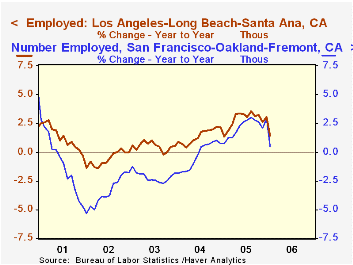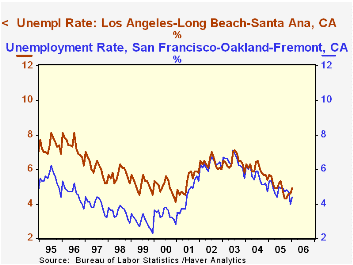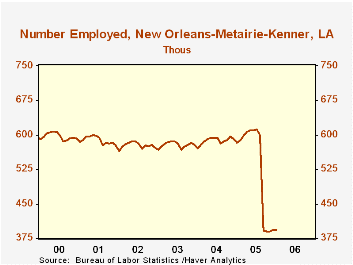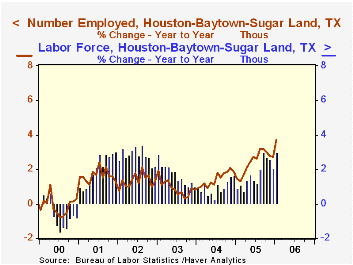 Global| Mar 17 2006
Global| Mar 17 2006"All Economics Is Local": Labor Markets in US Cities
Summary
This morning, the Bureau of Labor Statistics published January employment and unemployment data for US metropolitan areas. These are contained in Haver's EMPLR database. The database includes labor force, employment, unemployment and [...]

This morning, the Bureau of Labor Statistics published January employment and unemployment data for US metropolitan areas. These are contained in Haver's EMPLR database. The database includes labor force, employment, unemployment and unemployment rates for states, Census regions, metro areas and smaller municipalities. The data for states and some of the metro areas are available seasonally adjusted, but the data shown here for 8 selected large US metro areas are all not seasonally adjusted.
We spoke yesterday and the day before about labor market conditions in Europe and commented that such conditions can vary widely, even in neighboring regions there. The same is true here, as seen in the differences between Los Angeles and San Francisco. The economies of these two West Coast cities surely have differing characters, and this appears in the employment trends and the level of the unemployment rates. Employment growth in LA has generally been stronger, but the unemployment rate in San Francisco tends to be lower.
Denver, with a fairly consistent growth trend over the past several years nevertheless has an unemployment rate slightly higher than the national average, at least in the latest month. We are pleasantly surprised by the good growth in our own locale, New York City, over the past two years, a nice cyclical rebound after the 2001 recession and the developments associated with 9/11.
Such major non-economic events can have a pointed economic impact, of course. Hurricane Katrina was devastating to the economy of New Orleans, and these figures show how dramatic that has been. Employment in the New Orleans-Metairie-Kenner MSA is off by nearly 200,000 from a year ago. The unemployment rate there is more than 50% higher than for the nation as a whole. Notably, though, employment has edged upward in the last three months. The increase totals only 2,900, but it's certainly a step in the right direction for that city.
Finally, Houston may be a beneficiary of migration out of New Orleans. Even though the September "reference week" for labor market data was very soon after the storm, that month showed a marked and unusual increase in the Houston area labor force. Compared with the total drop in New Orleans, this 24,700 increase is just a fraction, but September has often been a month when the Houston labor force declines, implying that a special factor was in play. A boost to employment in Houston seems to have come just in January, when the normal post-Christmas drop in the number employed did not take place, but instead held just about steady with December. In the previous 16 years of data, the smallest decrease in January was 14,000.
It is often said that "all politics is local". The widely varying developments in labor markets reported this week in both entire adjoining countries and individual US cities suggest that much of economics must be local too.
| Jan 2006 | Mo/Mo % Chg | Jan 2005 | Yr/Yr % Chg | 2005 | 2004 | 2003 | ||
|---|---|---|---|---|---|---|---|---|
| Unemployment Rate | Number Employed | |||||||
| Total US | 5.1 | 141,481 | -1.0 | 138,682 | 2.0 | 1.8 | 1.1 | 0.9 |
| Los Angeles | 4.9 | 6,117 | -2.9 | 6,032 | 1.4 | 2.9 | 1.4 | 0.5 |
| San Francisco | 4.4 | 2,078 | -3.1 | 2,067 | 0.5 | 2.2 | -0.3 | -2.2 |
| Denver | 5.3 | 1,238 | -0.3 | 1,222 | 1.3 | 1.2 | 2.1 | 1.6 |
| Houston | 5.6 | 2,512 | -0.0 | 2,422 | 3.7 | 2.4 | 1.4 | 0.9 |
| New Orleans | 7.8 | 394 | 0.2 | 582 | -32.4 | -9.6 | 1.5 | 0.2 |
| Chicago | 5.6 | 4,466 | -0.2 | 4,440 | 0.6 | 0.8 | 1.2 | -0.0 |
| Boston | 4.7 | 2,317 | -1.4 | 2,311 | 0.2 | 0.1 | 0.0 | -1.3 |
| New York | 5.1 | 8,742 | -0.5 | 8,570 | 2.0 | 1.6 | 1.3 | -0.2 |
Carol Stone, CBE
AuthorMore in Author Profile »Carol Stone, CBE came to Haver Analytics in 2003 following more than 35 years as a financial market economist at major Wall Street financial institutions, most especially Merrill Lynch and Nomura Securities. She had broad experience in analysis and forecasting of flow-of-funds accounts, the federal budget and Federal Reserve operations. At Nomura Securities, among other duties, she developed various indicator forecasting tools and edited a daily global publication produced in London and New York for readers in Tokyo. At Haver Analytics, Carol was a member of the Research Department, aiding database managers with research and documentation efforts, as well as posting commentary on select economic reports. In addition, she conducted Ways-of-the-World, a blog on economic issues for an Episcopal-Church-affiliated website, The Geranium Farm. During her career, Carol served as an officer of the Money Marketeers and the Downtown Economists Club. She had a PhD from NYU's Stern School of Business. She lived in Brooklyn, New York, and had a weekend home on Long Island.





